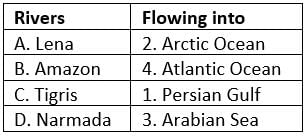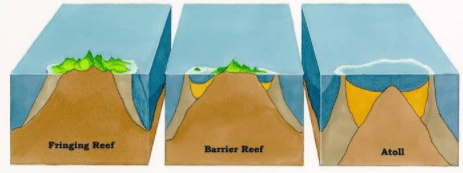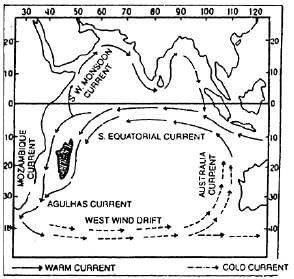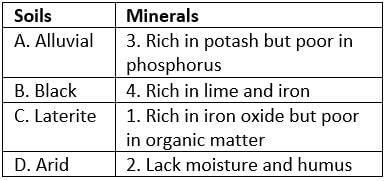Test: Geography - 4 - UPSC MCQ
30 Questions MCQ Test - Test: Geography - 4
With reference to lakes in India, consider the following statements
1. Wular lake is the largest salt water lake in India.
2. Kolleru lake is a freshwater lake.
3. Gurudongmar lake is situated in Himachal pradesh.
Which of the above statements is/are correct?
2. Kolleru lake is a freshwater lake.
3. Gurudongmar lake is situated in Himachal pradesh.
Which of the following statements is correct regarding the Ionosphere layer of the atmosphere?
| 1 Crore+ students have signed up on EduRev. Have you? Download the App |
Consider the following statements regarding LADIS – Least Available Depth Information System:
1. It is being implemented by Ministry of Jal Shakti.
2. It gives real-time data on the least available depths (LADs) to ships and cargoes.
3. Presently the information of LADs is being used by all the national waterways.
Which of the above statements is/are correct?
1. It is being implemented by Ministry of Jal Shakti.
2. It gives real-time data on the least available depths (LADs) to ships and cargoes.
3. Presently the information of LADs is being used by all the national waterways.
Which of the above statements is/are correct?
Which of the following is/are the salt water lakes of India?
1) Pangong tso lake
2) Tso moriri lake
3) Sambhar lake
4) Chilika lake
5) Pulicat lake
Consider the following statements regarding soil profile and horizons:
1. There is a gradual increase of organic matter with increasing depth.
2. The level of aeration of the soil decreases from the surface downwards in the soil profile.
Which of the above statements is/are correct?
Consider the following statements regarding phosphorous cycle:
1. A phosphorous cycle is an example of a sedimentary cycle.
2. Phosphorous is mainly found as phosphates in the earth’s crust.
3. Tectonic upliftment and denudation are the main processes responsible for the phosphorus cycle.
Which of the above statements is/are correct?
With reference to Passes in India, which of the following statements is/are incorrect?
1. Thaga La pass lies in Arunachal pradesh
2. Sach pass lies on sino-indian border
Match the following pairs of Rivers and the Water bodies they are flowing into:
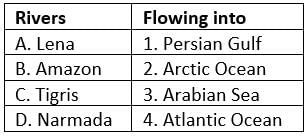
Select the correct answer using the code given below:
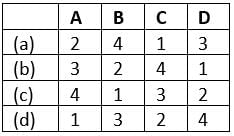
Consider the following statements:
1. Coral reefs are formed from the deposition of dead algae.
2. Adam’s bridge consists of shoals.
3. Barrier reefs are formed close to the shore line.
Which of the above statements is/are correct?
With reference to soil and its formation, which of the following statements is/are correct?:
1. Soil particles are classified as sand, silt and clay.
2. Erosion occurs when sand blows against exposed rocks.
3. The texture of a soil is determined by the soil particle’s shape.
Which of the above statements is/are correct?
Consider the following statements regarding Ganga River System:
1. It consists of perennial rivers only.
2. It consists of rivers originating in the Himalayas only.
Which of the above statements is/are correct?
“A contour line is a curve connecting points of equal value”. In this context, match the following:
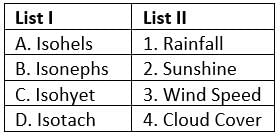
Select the correct answer using the code given below:
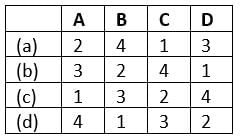
Consider the following statements regarding Aichi Targets:
1. These targets were set under Cartagena Protocol to the Convention on Biodiversity.
2. They aim to address the causes of biodiversity loss.
Which of the above statements is/are correct?
Consider the following statements regarding the Hot Springs:
1. They are associated with a volcanic region.
2. ‘Old Faithful’ in Yellowstone National Park of USA is the world’s best known hot spring.
Which of the above statements is/are correct?
“Though the proportions of different salts remain constant in all oceans, there are salinity variations”. In this context, consider the following statements:
1. The highest salinity is found in equatorial lakes and seas
2. Chandrataal lake is freshwater glacial lake
3. The salinity of the Caspian Sea is lower than the Black Sea
Which of the above statements is/are correct?
Match the following:
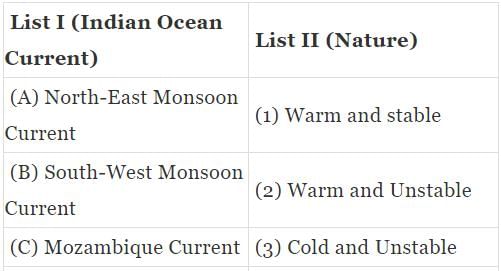
Select the correct answer from the code given below:
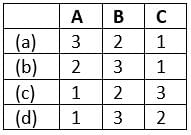
Which of the following sources is not a direct source of information about the interior of the Earth?
Consider the following statements regarding Isotherms:
1. They are generally parallel to the latitude.
2. In January, the isotherms deviate to the south over the ocean and to the north over the continent.
Which of the above statements is/are correct?
With reference to Peninsular rivers, consider the following statements:
1. Sardar Sarovar Dam is built on Mahanadi River.
2. Krishna River rises from Trimbak Plateau of North Sahyadri.
3. Manjira is the left bank tributary of Godavari.
Which of the above statements is/are correct?
Fold Mountains are formed by the large scale lithospheric movements in the earth’s crust. Which of the following factors lead to the formation of Fold Mountains?
1. Increased load of the overlaying rocks.
2. Flow movements in the Mantle.
3. Magmatic intrusions into the crust.
Select the correct answer using the code given below:
With reference to Koeppen’s climatic classification, consider the following statements:
1. It is an empirical classification.
2. Koeppen used certain values of temperature and precipitation for classifying the climate.
Which of the above statements is/are correct?
Madden-Julian Oscillation (MJO) is a coupling similar to that of El-Nino Southern Oscillation (ENSO) but differs from it in many ways. Consider the following statements regarding Madden-Julian Oscillation:
1. Unlike El-Nino Southern Oscillation which is a travelling pattern, MaddenJulian Oscillation is a standing pattern.
2. It is good for Indian sub-continent as it increases the amount of rainfall during monsoon when it establishes on Indian Ocean.
Which of the above statements is/are correct?
Which of the following process(es) can be best associated with Diastrophism?
1. Mountain building through severe folding of the earth’s crust.
2. The heat generation by the radioactive elements in earth’s interior.
3. Weathering, mass wasting, erosion and deposition.
Select the correct answer using the code given below:
Which of the following constitute the soil forming processes?
1. Soil enrichment
2. Loss of material from the soils
3. Translocation of materials
4. Transformation of materials
Select the correct answer using the code given below:
Consider the following statements regarding solstices:
1. The summer solstice for the northern hemisphere occurs when the sun is directly over the tropic of cancer.
2. Solstices occur because the Earth’s axis of rotation is tilted.
3. Winter solstice marks the shortest day and longest night.
Which of the above statements are correct?
Consider the following statements regarding the Depositional landforms of Groundwater:
1. Stalactites rise up from the floor of the caves.
2. Stalagmites may develop a miniature crater-like depression.
Which of the above statements is/are incorrect?
Match the following:
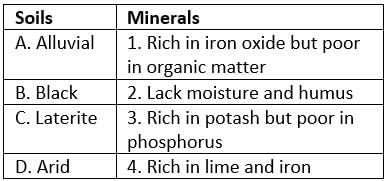
Select the correct answer using the code given below:
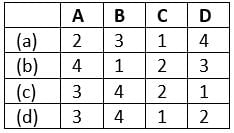
Match the following:

Select the correct answer using the code given below:



